Greenhouse Cucumber Production:
The following content details Greenhouse Cucumber Production / Polyhouse Cucumber Production.
Introduction of Greenhouse Cucumber Production:- Growing cucumber in the greenhouse is a fun and profitable business. Most people are showing interest in the greenhouse production of cucumbers as they can be grown in a controlled environment throughout the year. Apart from this, there are subsidies and loans available for building greenhouse and Polyhouse. As demand for organic vegetable farming is growing, greenhouse cultivation of vegetables also increasing rapidly. One can obtain decent profits under a protected environment (For example greenhouse/Polyhouse/shade net) conditions. Cucumbers can also be grown hydroponically in the greenhouse. Cucumbers can be grown in backyards, containers, pots, balconies, and home gardens. With proper standing support, you can expect them to creep fast and yield more.
The cucumber is one of the widely grown plants in the gourd family for its dark green vegetable. When it comes to cucumber plant description, It is a creeping vine that roots in the ground and grows up trellises or other supporting frames, structures, spiraling tendrils. The cucumber plant may also root in a soil-less medium such as a hydroponic system. The cucumber vine will sprawl along the ground if it t provided any support to grow vertically. Usually, The cucumber vine has large leaves with a form of canopy over the fruits. The cucumber fruits are in a cylindrical shape and elongated with tapered ends. The size of cucumbers depends on the variety. However, cucumbers can be as large as 60 centimeters long and 10 centimeters in diameter. In the upcoming sections, let us talk more about greenhouse cucumber production/Polyhouse cucumber cultivation.
Scientific Name Cucumber:- Cucumis sativus.
Family Name of Cucumber:- Cucurbitaceae.
Genus of Cucumber:- Cucumis.
Cucumber in Indian Languages:- Cucumber is being called with different names in Indian languages.
English: Cucumber.
Hindi : Khira / Kheera / Kakdi.
Tamil: Vellarikka.
Telugu: Keera Dosakaya.
Malayalam: Vellarikka.
Kannada: Savatekai.
Konkani: Thaushe.
Bengali: Sasha / Sausha.
Marathi: Sitalchinni.
Gujarati: કાકડી (Kakdi).
Urdu: Kakdi.
Kashmiri: laer.
Oriya: Kakudi.
Punjabi: ਖੀਰਾ/ Khīrā.
Health Benefits of Cucumber:- Well, most of the time vegetables grown in the greenhouse are organic and they have excellent health benefits when compared to vegetables grown in the traditional way. The following are some of the health benefits of cucumber vegetables grown in a greenhouse.

- Organic cucumbers grown in the greenhouse are free from chemicals.
- Regular consumption of cucumber keeps the body hydrated.
- They can flush out toxins from the body.
- Cucumbers are a good source of vitamins like ‘A’, ‘B’, and C.
- It is excellent to fight with body heat.
- Good for skin health
- Cucumbers are low in calories, hence aids in weight loss.
- Cucumbers are good for eye health.
- Regular eating of cucumber may cut cancer risk.
- They are also good at stabilizing blood pressure.
- Cucumbers are good for kidney health.
- Cucumbers are good for diabetics.
- Cucumbers can help in lowering cholesterol.
Varieties / Types (Cultivars) in Greenhouse Cucumber Production:- Well there are many improved varieties available for greenhouse/Polyhouse cultivation depending on the region and market demand.
Actually, there are 3 main varieties of cucumbers
- Slicing variety.
- Pickling variety.
- Seedless variety.
Most of the varieties are being created from above stated main cultivars.
Continental cucumbers:
- These varieties are 30 to 50 cm long with dark green colour.
- These types of cucumbers have smooth skin slightly ribbed, with a glossy finish.
Lebanese (or) mini cucumbers:
- These varieties are about 15 to 20 cm long with green colour and glossy finish.
- These cultivars can be harvested very quickly from flowering, with less bent fruit, especially in the winter season.
Note: Varieties of cucumber may vary with quality, yields, disease tolerance, cold condition tolerance. One should understand that cucumbers have different varieties for both warm and cold seasons.
Growing Conditions for Greenhouse Cucumber Production:- The following conditions are ideal for growing cucumbers in a Greenhouse/Polyhouse/any protected environment.
- Select a polythene greenhouse with abundant light and ventilation.
- Ensure the height of the greenhouse/Polyhouse to the gutters should preferably be over 5 meters.
- Selection of plant growing site should be north-south facing rows within the greenhouse/Polyhouse.
- For better plant growth, the optimal humidity in the greenhouse should be maintained. In this case, 80% of relative humidity should be maintained and this can be checked by using a hygrometer.
- As high humidity results in powdery mildew disease, ventilation can be adjusted to maintain optimum temperatures and humidity.
- Do not over ventilate the planting area as this can reduce the relative humidity and can result in lower yields and fruit can have gummy ends.
- Fans may also be used for cooling and ventilation. You have to make sure the misters do not increase the relative humidity too high.
- The cucumber plant needs a light level of about 45,000 to 50,000 lux. A thermal blanket over the crop can be used to automatically provide the shade for the plants at a selected temperature of 32 °C. In a hot climate, and you can decrease day temperatures. If there is no thermal blanket used, in the warmer climatic months, it is recommended to maintain the temperatures above 15°C and in winters, optimum temperatures should be 23 to 34ºC. Temperatures over 40ºC or less than 14°C are not favorable to cucumber production in the greenhouse.
Propagation in Greenhouse Cucumber Production:- Cucumbers are propagated by seeds.
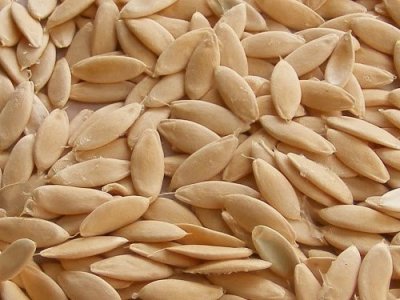
Season and Seed Rate in Greenhouse Cucumber Production:- In the greenhouse, they can be cultivated throughout the year. Seed rate depends on variety, planting method.
Seeding/Sowing/Transplanting in Greenhouse Cucumber Production:- Before transplanting in the greenhouse, seedlings must be raised in seed trays.
In case if you miss this: Vegetable Farming At Home.
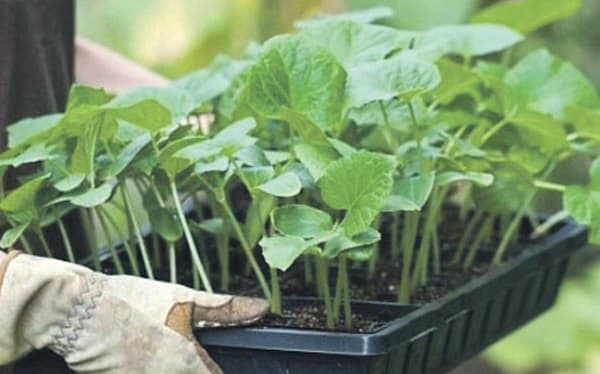
- Seeding should be done in sterilized plastic cell trays which are filled with good potting mix.
- Ensure to cover the seeds with 8 to 10 mm of perlite.
- Cucumber seeds can also be planted into peat blocks, 5 cm pots, or 6 – 8 cm Rockwool blocks for 3 to 6 weeks before planting into the greenhouse.
- Cucumber seedlings may be transplanted at the 3 to 4 leaf stage. The Rockwool blocks
- should be placed directly on top of the slabs.
- Some vegetable growers may seed directly into bags in summertime and transplant in wintertime.
- Lower temperatures may result in slower germination and uneven sprouting. This can also be the cause of plants having poor vigour.
- The day and night optimal temperature is 27°C for better germination of cucumber seeds.
Spacing in Greenhouse Cucumber Production:-
- Cucumber seedling’s density should be of 1.5 winters and of 2 in summer per sq. meter, with plant distance of 45 to 60 cm, with double rows on 2-meter centers.
- Lebanese cucumber variety can be planted slightly closer up to 3 to 4 plants per square meter than continental cucumbers.
- Do not plant very closely, this can result in poor yields and they can build up diseases due to insufficient light.
Irrigation / Nutrient Supply in Greenhouse Cucumber Production:- For organic cucumbers, you must use organic fertilizers, micro-nutrients, and plant growth regulators for nutrients supply through irrigation.
Cropping Schedules in Greenhouse Cucumber Production:-
- Though the cucumbers can be grown in a greenhouse throughout the year, the best cropping periods are from Aug to Nov & April to May.
- If there is an extreme temperature in summer then summer cropping will be difficult.
- Under ideal conditions, greenhouse cucumbers can yield for 1 year. However, the normal picking period is much shorter. Most of the time, greenhouse growers often have 3 crops/year.
Training, Fruit Thinning, and Pruning in Greenhouse Cucumber Production:-
- Make sure to remove the side shoots and tendrils on the main stem of the cucumber plant.
- When it comes to fruit thinning, thin to 1 fruit/ 2 nodes for the continental cultivars (varieties), especially curled fruits which may be visible after a couple of days.
- Do not carry out thinning the Lebanese cultivars (varieties), which may have more than 1 fruit on every node and up to 4 to 6 fruits/node. Tendrils must be removed if these wrap around the cucumber fruits.
- Should place the plant over a hoop, or plastic saddle at the top of the wire.
- Remove the growing point at the 4th leaf over the wire and allow 2 laterals to grow. These will grow downwards. Stop growth just before they reach the ground.
- Old and diseased leaves should be removed to allow better light and aeration into the plant center.
Manures and Fertilizers in Greenhouse Cucumber Production:- For growing cucumbers in soil beds, carry out the required potassium (K2O) and phosphorus (P2O5) and a little amount of nitrogen (N) before planting. The optimal fertilizer amounts of pre-planting per acre are 52 kilograms of nitrogen (N), 68 kilograms of phosphorus (P2O5), and 112 kilograms of potassium (K2O). Any micro-nutrient deficiencies in the soil, indicated by soil test or plant analysis, should be supplemented by incorporating them into the soil before planting.
In the case of soil-less farming or hydroponic growing of cucumbers, plants are grown with a complete nutrient solution. Should supply with a complete N:P:K slow-release fertilizers.
Flowering in Greenhouse Cucumber Production:- Cucumbers under greenhouse / Polyhouse conditions produce fruits without pollination. However, pollination can take place from nearby fields cucumbers which are monoecious (both male and female flowers). If flowers are pollinated in the greenhouse, seeds form in the fruit and the fruit becomes bitter and unmarketable.
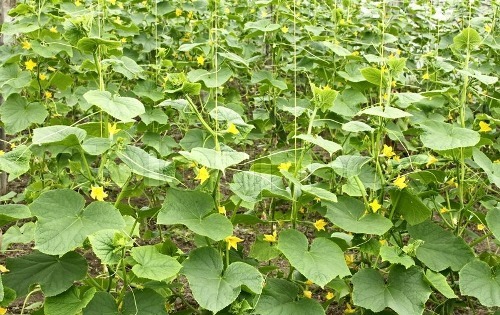
Diseases in Greenhouse Cucumber Production:- Symptoms on plant leaves begin as small dark water spots which enlarge and become light brown and finally a pale bleached colour affecting the plant growth and yield. Some of the diseases found in greenhouse cucumber production are
- Botrytis.
- Gummy stem blight fungus.
- Sclerotinia (This is the result of too closely planted vines, which can cause watery rot and finally make the plants to wilt, You must not plant closely and you should increase ventilation to prevent this).
Other diseases that may occur are:
- Bacterial spot
- Alternaria
- Fusarium Oxysporum.
As a preventive measure, you must use certified organic inputs (manures/organic fertilizers) to control this type of disease.
Harvesting in Greenhouse Cucumber Production:- The harvesting time can be 4 to 6 weeks after seedling in summer and 10 to 11 weeks in winter. Usually, summer cucumbers are ready for harvesting 2 weeks after flowering for the long varieties and 8 to 10 days after flowering for the Lebanese varieties.
With the help of a sharp knife or a sickle, cut the cucumbers by leaving 1 to 2 cm of the stalk at the end of the fruit. It is recommended to harvest the fruits in the early morning.
The frequency of harvesting cucumbers depends on the variety. In the case of Lebanese varieties, you may need to pick the days and whereas in the case of Continental varieties, you may need to pick the fruits every 2 days. Cucumbers should be picked carefully without any damage or marks. As we mentioned earlier, usually there are 3 crops per year in greenhouse farming. However, there may be a situation with 2 crops even with 1 crop per year.
Cucumbers thrive best in the warmer season or summertime. Long-term crops in a greenhouse in the warmer months (summer) may produce 35 to 40 fruit per plant. The average weight for Continental cucumbers is 550 to 600 grams but may weigh up to 1.5 kg.
Yield in Greenhouse Cucumber Production:- Yield of cucumber crop depends on variety, disease control, organic inputs, soil quality, irrigation, and other greenhouse management practices. On average, one can obtain a yield of 500 to 550 tonnes/ha/year, with about 85 to 90 fruit/ sq.meter/year. Lebanese cucumbers yield more than Continental cucumbers.
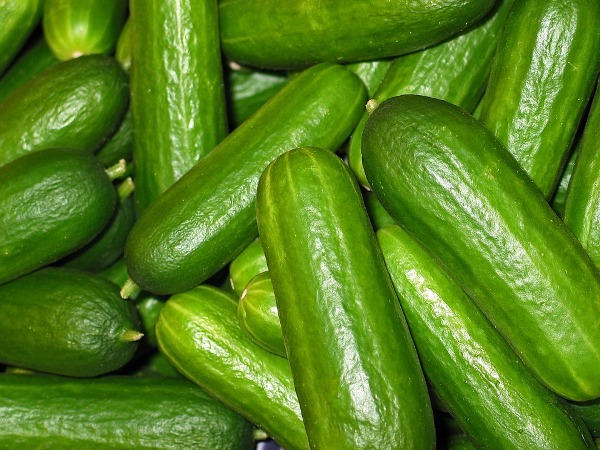
Marketing in Greenhouse Cucumber Production:- Freshly harvested cucumbers may be transported to local vegetable markets or can sell in bulk to any vegetable vendors. Most of the time, greenhouse vegetables are sold at the farm gate.
Tips in Greenhouse Cucumber Production:- Some tips to consider while growing cucumbers in a Greenhouse/Polyhouse.
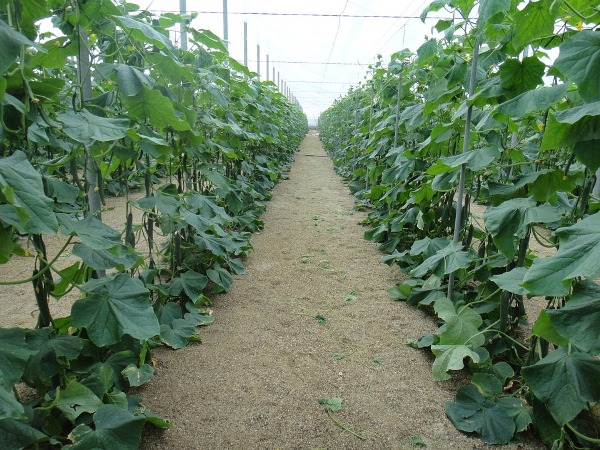
- Select disease-free, disease-resistant, and high-yielding varieties.
- Don’t consider marketing bent or marked or damaged cucumbers.
- To prevent the breakdown of the fruits, wash Lebanese fruits and dip them in a calcium hypochlorite solution. (containing 2 ppm chlorine).
- Good quality cucumbers are dark green, crisp in flavor.
- Remove any old flower parts at the end of the cucumber before grading and packing.
- Periodically check the humidity in the greenhouse as it impacts crop growth and yield.
- Make sure to sterilize all plant growing containers between uses in the greenhouse.
- Ensure the growing medium is free of plant disease organisms and care should be taken to store all the container/ pots and soil mix material where contamination can be avoided.
- If containers are used for growing the plants, fill these containers to a uniform depth and level the surface. Fill the containers to 1/2 to 3/4 inch from the upper edge to leave space for water during irrigations.
- when watering or supplying the nutrient solution, ensure to thoroughly wet the full depth of soil in the container to prevent any salt build-up and maintaining uniform moisture throughout the container.
- You should cover the seeded containers with clear polyethylene film until seeds start germination. This can also improve soil temperature and moisture conditions.
In case if you miss this: Growing Plants Using Hydroponics.
- Economical Aquaculture: A Guide to Low-Budget Fish Farming
- 15 Common Planting Errors That Can Doom Your Fruit Trees
- How to Make Houseplants Bushy: Effective Tips and Ideas
- Innovative Strategies for Boosting Coconut Pollination and Yield
- Pollination Strategies for Maximum Pumpkin Yield
- The Complete Guide to Chicken Fattening: Strategies for Maximum Growth
- Natural Solutions for Tulip Problems: 100% Effective Remedies for Leaf and Bulb-Related Issues
- Revolutionizing Citrus Preservation: Towards a Healthier, Greener Future
- Natural Solutions for Peony Leaf and Flower Problems: 100% Effective Remedies
- Maximizing Profits with Avocado Contract Farming in India: A Comprehensive Guide
- Natural Solutions for Hydrangea Problems: 100% Effective Remedies for Leaf and Flowers
- The Ultimate Guide to Choosing the Perfect Foliage Friend: Bringing Life Indoors
- From Sunlight to Sustainability: 15 Ways to Use Solar Technology in Agriculture
- The Ultimate Guide to Dong Tao Chicken: Exploring from History to Raising
- The Eco-Friendly Makeover: How to Convert Your Unused Swimming Pool into a Fish Pond
- Mastering the Art of Delaware Chicken Farming: Essentials for Healthy Backyard Flocks
- 20 Best Homemade Fertilizers for Money Plant: DIY Recipes and Application Methods
- How to Craft a Comprehensive Free-Range Chicken Farming Business Plan
- Brighten Your Flock: Raising Easter Egger Chickens for Beauty and Bounty
- How to Optimize Your Poultry Egg Farm Business Plan with These Strategies
- Subsidy for Spirulina Cultivation: How Indian Government Schemes Encouraging Spirulina Farmers
- Ultimate Guide to Raising Dominique Chickens: Breeding, Feeding, Egg-Production, and Care
- Mastering the Art of Raising Jersey Giant Chickens: Care, Feeding, and More
- Ultimate Guide to Raising Legbar Chickens: Breeding, Farming Practices, Diet, Egg-Production
- How to Raise Welsummer Chickens: A Comprehensive Guide for Beginners
- How to Protect Indoor Plants in Winter: A Comprehensive Guide
- Ultimate Guide to Grow Bag Gardening: Tips, Tricks, and Planting Ideas for Urban Gardeners
I Want To Set Up A Polyhouse Project In Banswara, Rajasthan,So Please Help Me Out And Give an Information About this.
Check this:Polyhouse Projects.
Please suggest a good quality cucumber seeds with rate for our shade net farming
Thank you for the info.
But can any variety of cucumber be planted in the greenhouse?
I have 5000 sqft area near high way and i want to put a polyhouse prject in west bengal .So pl. guide me in details , So that i could start the Project